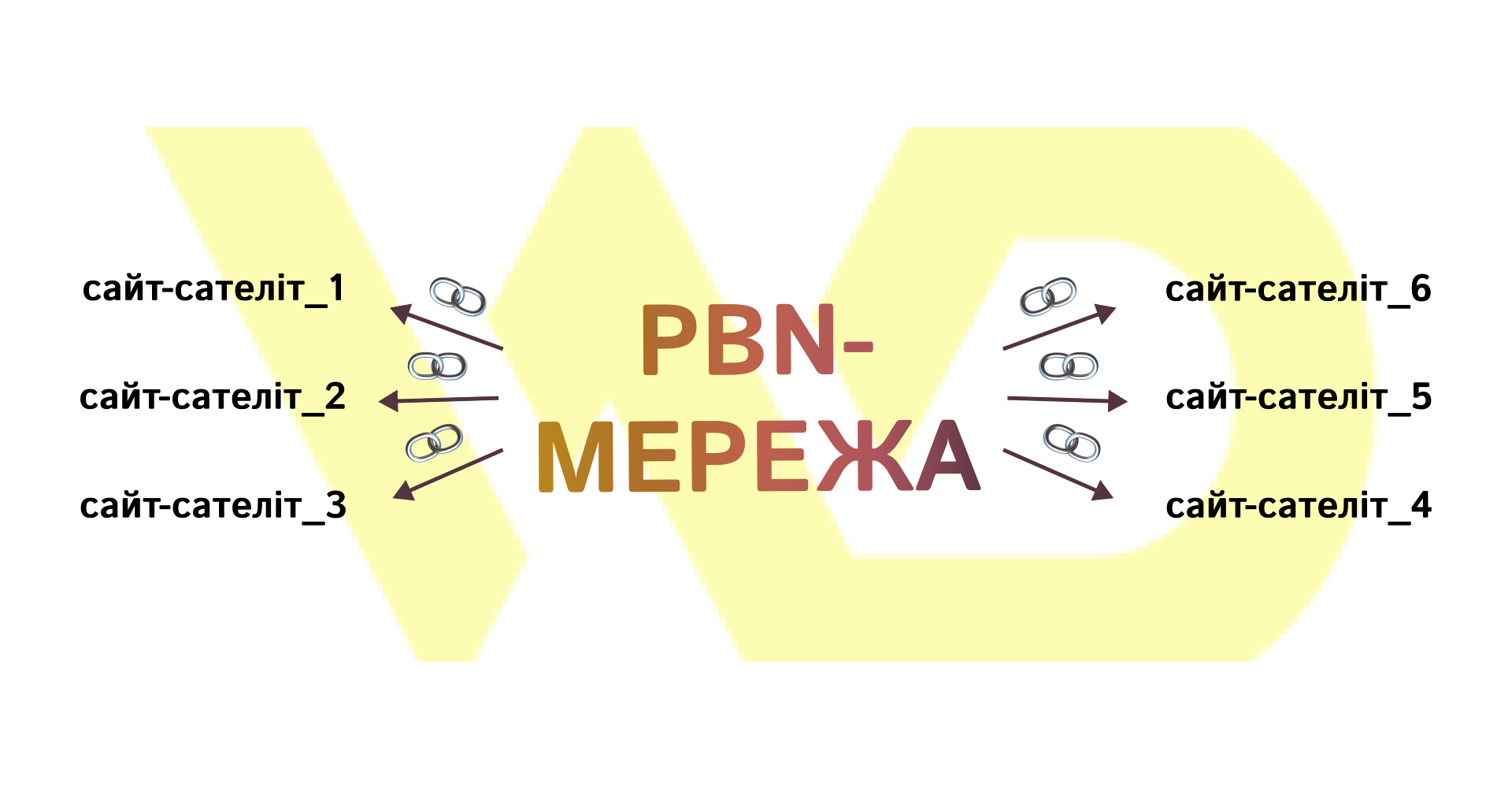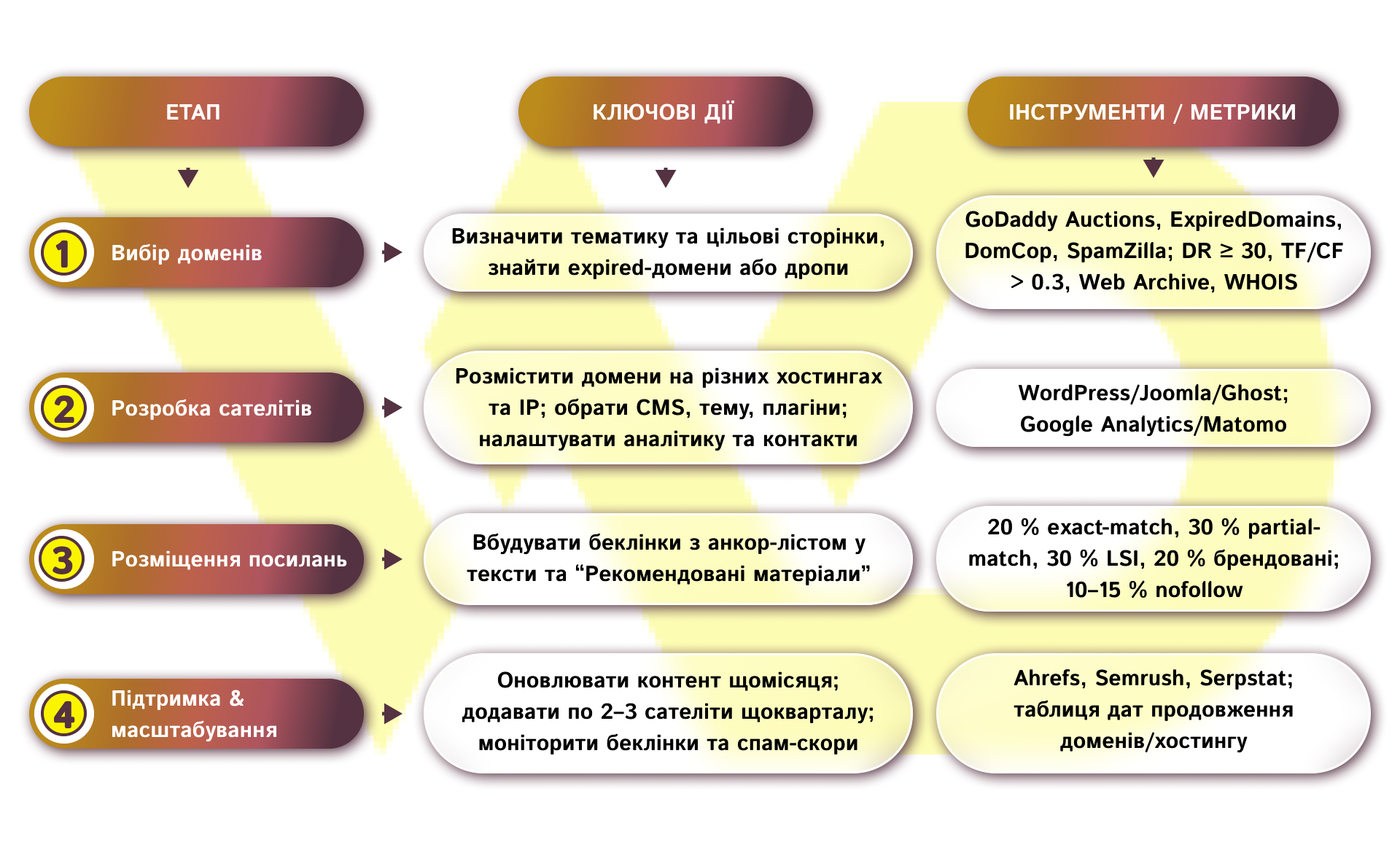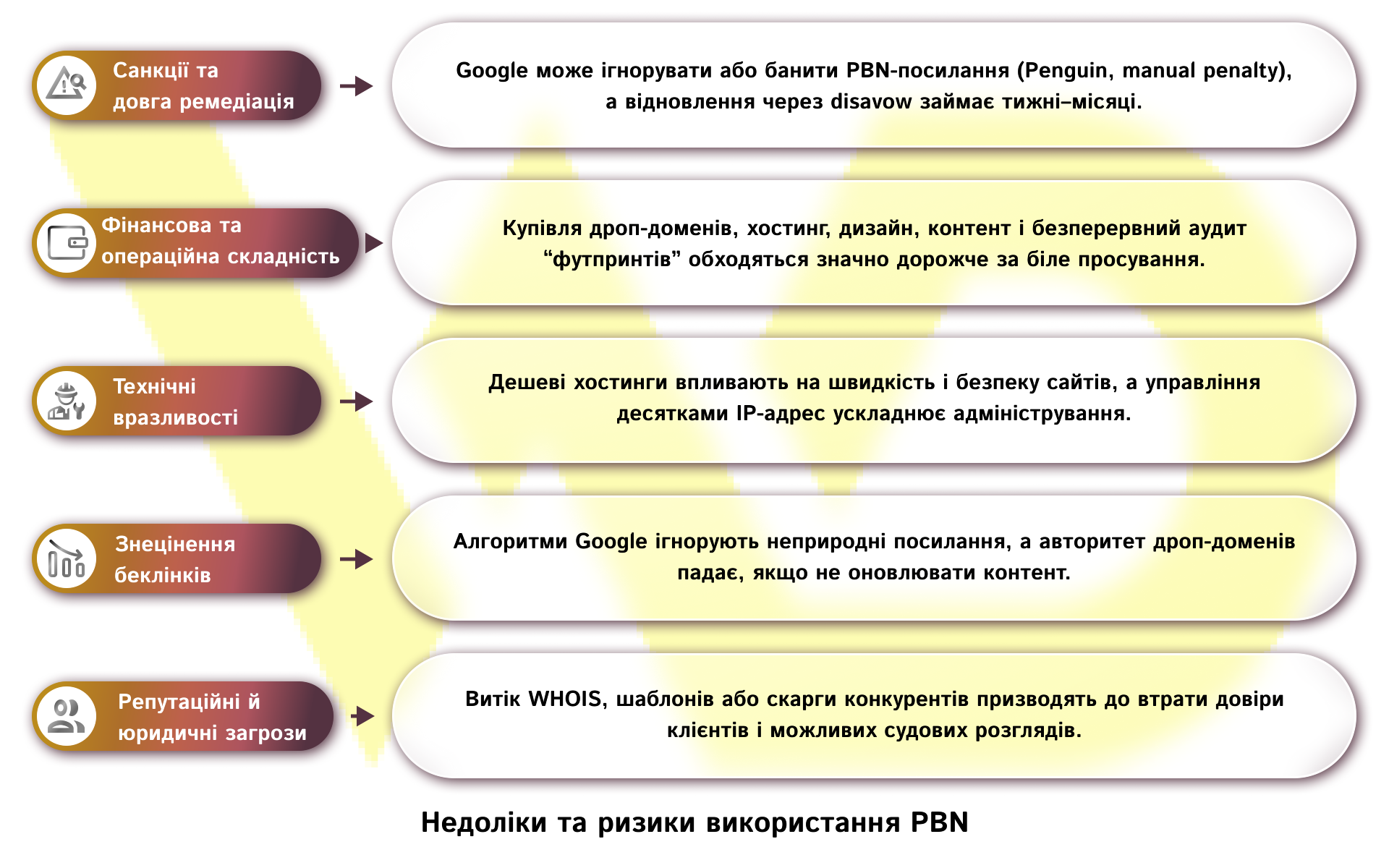Content of the article


Today, SEO has a full range of methods – from «white hat» promotion based on natural content and organic link building to «black hat» techniques that grossly violate search engine rules. Somewhere in the middle are gray tools, one of the most common of which is PBN networks. Understanding how PBNs work allows marketers and website owners to assess both potential short-term benefits and long-term risks, and ultimately choose the most appropriate promotion strategy.
A PBN network is a specially created or acquired group of satellite sites that mutually link to the main resource to artificially increase its authority in the eyes of Google as part of a dubious SEO promotion. On the one hand, a PBN network can provide rapid growth of positions and traffic without long-term efforts for «white» link building, which is especially attractive when launching a new project or after losing traffic due to algorithm updates. On the other hand, the use of PBN tools in SEO promotion is necessarily associated with strict Google rules, financial costs for domain purchase and web resource maintenance, constant concealment of technical footprints, and the risk of sanctions that can lead to partial or complete deindexation.
In this article, we will take a closer look at what a PBN network is, analyze its key characteristics, and the main stages of building and maintaining a PBN network. We will also weigh all the pros and cons so that business owners can make an informed decision whether to include PBN in their SEO strategy.
What is a PBN network?
PBNs (Private Blog Networks) appeared at the beginning of the SEO era in the mid-2000s, when Google started taking into account not only the quantity but also the quality of external links as a key ranking factor. Back then, search engine optimization specialists realized that if you create your own PBN network of donor sites, fully controlled by one owner, you can quickly boost the authority of your main resource even in difficult conditions of competitive promotion.

Initially, the PageRank algorithm evaluated mainly the volume of so-called link juice, without delving into the quality of donor domains. That’s why buying and registering dozens of blogs with subsequent manual placement of backlinks gave an instant SEO effect without the risk of detection and without the need for long-term promotion. Later, with the introduction of Panda, Penguin, and artificial intelligence algorithms, approaches to creating PBNs became more complex: footprints appeared, characteristic technical features that identify a network and provoke sanctions for its use.
The three main characteristics of any PBN network have remained unchanged:
- independence of sites: each resource on the network is fully owned and managed by the PBN owner;
- flexibility in link placement: backlinks can be created both manually and automatically, with the ability to accurately select anchor texts;
- hidden infrastructure: satellites are placed on different hosts, use different CMS and contact information to avoid detection of common footprints.
To better understand what a PBN network is in the context of modern SEO and integrated promotion, let’s imagine a webmaster who has decided to apply this approach. He can buy 20 high-traffic drop domains (DR, Ahrefs AR, RD), launch unique satellite blogs on them, optimized for the right keywords, and then place high-quality links to the main site in their materials. Thanks to this scheme, the main resource receives a controlled flow of link juice and quickly improves its position in the search results.
Now that we’ve dealt with the basic features of PBN and how this method fits into the overall SEO and promotion strategy, let’s move on to describe different satellite formats and their features.
Types of PBNs and their features
Before launching a PBN network for SEO promotion, companies should understand what types of satellite sites to use, as this will determine the technology of PBN network development and risks.
- Social networks and guest blogs.
This is the easiest and cheapest way to collect a basic pool of donors: create profiles, groups, and microblogs on free platforms (such as WordPress.com, LiveJournal, Medium, Blogger) and publish posts with backlinks to your main site. This tactic in SEO promotion requires minimal resources, but the link weight is usually low, and search engine algorithms quickly ignore posts that are not supported by authority.
- Expired Domains have been restored.
The goal is to buy domains with a history of backlinks and traffic, clean them from spam, set up hosting, and fill them with unique content. The selection process is based on the DR ≥ 30 and TF ≥ 20 metrics, and snapshots from the Web Archive help to check past topics. This approach requires a thorough development of a content strategy and additional costs, but it can provide a strong starting impulse.
- A niche network.
Here, the satellites should match your niche as closely as possible. For example, an online furniture store can complement PBN with interior decor blogs, DIY tips, and home improvement trends. This method of promotion looks more natural, increases conversion, but requires serious development of expert content and design.
- Hybrid meshes.
This format combines different types of satellites: drop-down domains, social networks, and thematic microblogs. An unscrupulous promotion agency can balance the budget in this way and increase the stability of the network: if some sites are «exposed,» others will continue to work without interruption.
- Automated PBN services.
There are SaaS solutions and agency services on the market that create and maintain PBNs on a turnkey basis. They remove some of the work of website development and technical support, but reduce the level of control over domains and may leave traces of a single provider.
Note that combining different types of satellites increases the resilience of a PBN network, but also makes it more difficult to coordinate and monitor. In any case, an effective PBN strategy requires constant analysis of the results and adaptation of tools to changes in search engine algorithms. Remember: even the best modern PBN methods can become outdated, so it is important to regularly reassess approaches and invest resources in quality, not just quantity of sites.
Now that it’s clear what the grid consists of and how a company can build it, let’s see how to launch it step by step.
How does a PBN network work?

A PBN network is built in four key stages, each of which requires clear planning, special tools, and attention to detail. This is necessary to minimize the footprint of the network and avoid search engine penalties as part of a complex SEO promotion.
Selecting domains
The first step of a company or agency developing SEO strategies using gray hat methods is to define the grid topics and landing pages of the main website. Then they use GoDaddy Auctions, ExpiredDomains.net, DomCop, and SpamZilla to find expired domains or drops with a history of traffic and backlinks. They analyze Domain Rating (DR ≥ 30), Trust Flow/Citation Flow (> 0.3), check Web Archive, and examine WHOIS data. This approach allows you to make an informed choice and order the right domains without unnecessary risks.
Development of satellite sites
The selected domains are hosted by different hosting providers in different C-Class IP bands. For each satellite, the agency chooses a separate CMS (WordPress, Joomla, Ghost), a unique theme and a set of plugins, sets up analytics and contact information. The content for each blog is written in a different style and length (500-2,000 words), multimedia and external links are added to create a realistic blog resource.
Placement of links
After indexing on the satellites, backlinks to the main site are embedded in articles and the Recommended Reading section with a well-thought-out anchor list: 20% exact- match, 30% partial-match, 30% LSI keys and 20% branded texts, as well as 10-15% nofollow links. This allows promotion through PBN to give the maximum signal to Google and make promotion more flexible.
Support and scaling
To ensure that the PBN network works for a long time, the agency regularly updates content, orders new materials, and adds 2-3 satellite sites every quarter. New links and changes in spam rates are monitored using Ahrefs, Semrush, or Serpstat. All domain and hosting registration dates are recorded in a spreadsheet so that the company can renew resources on time and avoid downtime.
Let’s take an example
Let’s say the task is to promote an online store gadgets with a budget of 50,000 UAH for 6 months. The business owner wanted a quick effect in SEO, so they decided to try the PBN network.
- April: purchase of 10 drop domains through DomCop with DR ≥ 35 and TF ≥ 20 – 12,000 UAH.
- May: development and launch of satellite sites on various CMS, first articles (blog with guides on how to make and where to buy a gadget) – UAH 10,000.
- June-July: placement of 3 backlinks with anchors «buy a gadget» and «order accessories» on each satellite – 15 000 UAH.
- August-September: updating content, adding 2 new satellites, and monitoring performance through Ahrefs and Google Analytics – UAH 8,000.
Results for two months of such SEO promotion:
- Organic traffic grew by 30%.
- The store reached the TOP-5 for «buy a smartphone» and «order gadgets».
- The conversion rate increased from 2.0% to 2.3%, which resulted in about 250 additional orders.
- The average cost per lead (CPL) was about 180 UAH, and the additional revenue was about 250,000 UAH, i.e. ROI ≈ 456%.
The effect slowed down after the third month. Organic traffic growth dropped to 5-7% per month, and conversion rates stabilized. This showed that even a well-constructed PBN network gives only a short-term boost and requires regular development of new satellites or alternative promotion channels.
Advantages of the PBN network
Despite the «gray» nature of the PBN network, it is often chosen for the possibility of fine control over the entire link strategy.
- Control over the link mass. You decide what kind of anchors to use (exact-match, partial-match, branded, etc.), how many links to place, and where exactly in the text of your blog or website. In addition, you can A/B test different anchor wording with UTM tags to track which ones improve CTR and behavioral signals. Thanks to this, the company regulates not only the quality but also the link velocity – the speed of new links, which helps to avoid sudden jumps in promotion that are suspicious to Google’s algorithms.
- Fast results. The first improvements in rankings are often noticeable within 2-4 weeks after publishing content on satellites. The higher the donor metrics (DR, TF), the more noticeable the initial «boost» is. However, without the regular addition of high-quality backlinks, growth may slow down, so the agency should continue to develop new satellites and SEO strategy.
- Guarantee of backlinks safety. You own all domains and hosting, so no donor can suddenly remove your link or change the terms of cooperation. For greater security, you can order automatic renewal of domains and hosting, as well as regular backup of content in case of technical problems.
- Flexibility of scaling. If necessary, you can quickly order and buy several drop domains with good metrics or add new satellites in different niches. Thanks to scripts and API services (Expired Domains, GoDaddy API, etc.), the launch of new turnkey websites for the development of a PBN network can take a few hours. This allows you to quickly respond to seasonal changes in demand or supplement the semantic core without delays.
The PBN network is attractive due to its advantages. At the same time, it should be borne in mind that these advantages require significant investments in infrastructure support and thoughtful concealment of footprints, and are accompanied by a high risk of sanctions from search engines.
Disadvantages and risks of using PBN

Despite the attractiveness of fast results, PBN networks hide a number of risks that can destroy both the website’s search rankings and the company’s reputation. Even with perfect technical execution, without constant monitoring and readiness to respond quickly to any network footprints, the losses can be irreparable.
- Sanctions and long remediation.
Google actively detects artificial link building schemes. According to Ahrefs, for violating the Webmaster Guidelines, PBN links are immediately blacklisted by Penguin algorithms and artificial intelligence, which ignores «unnatural» backlinks or reduces their weight. Search Engine Journal writes that if it comes to a manual penalty, Google specialists can completely remove the site from the index. And the subsequent recovery process by submitting a disavow file and waiting for a reconsideration takes from several weeks to several months.
- Financial and operational complexity.
Running and maintaining even a small PBN is much more expensive than building organic backlinks. The purchase of expired domains with DR ≥ 30 and TF ≥ 20 costs from $50 to $500 per domain, and their annual renewal costs $10-50. The cost of various hosting services (VPS, shared hosting, VPN) is another issue – approximately another $10-50 per site per month. CMS design and customization costs $100-200, and the creation of high-quality articles (1000-2000 words with multimedia) costs $30-100 each. Finally, constant audits of footprints (WHOIS, IP clustering, CMS updates, changing anchor lists) take a lot of time and effort.
- Technical vulnerabilities.
PBN sites often run on low-cost hosting, which leads to slow loading and frequent downtime, which affects both user experience and SEO. At the same time, outdated plugins and themes can open the way for hackers, and the infection of one satellite will spread throughout the entire PBN network. Add to this the need to manage dozens of separate IP ranges, and you get another point of potential failure.
- Devaluation of backlinks.
Even without Google’s sanctions, PBN links lose their effectiveness: algorithms are smart enough to ignore «unnatural» links, and the domain authority of drop domains falls over time if the site is not updated. In addition, an excessive accumulation of single-profile backlinks arouses suspicion, and further attempts at building from «similar» resources have less and less impact on rankings.
- Reputational and legal threats.
If information about the use of PBNs is leaked (WHOIS leakage, access to website templates, or complaints from competitors), it will cause a wave of negativity: customers, partners, and industry media will turn away because PBNs are considered an unfair tactic. In the worst case scenario, fraudulent WHOIS registration or violation of hosting terms can lead to lawsuits and domain blocking.
The advantages of PBN – control, speed, link guarantee, and scalability – are heavily offset by high costs, technical and legal challenges, and most importantly, the constant threat of Google penalties and loss of reputation. For long-term and sustainable SEO promotion, these risks often outweigh the short-term benefits.
Experts in link building are generally categorically against the lying of the PBN network. In particular, the founder of LinkResearchTools, Christoph Champion, notes:
«Bottom line: never participate in a PBN. I would never advise you to even go near a PBN or create your own – it’s too much of a risk. If you have a commercial website and this is your livelihood, the answer is never.»
The psychological impact of falling positions
When a website loses its position in the search results, it hits user confidence as hard as it hits the budget. According to Backlinko, the first place in Google receives an average of 27.6% of all clicks, while the second position is only 15.3%, and the third – 10.2%. Advanced Web Ranking in its research shows that the results of the second page are already at the level of 3% CTR or less.
These figures affect not only traffic but also brand perception. When a website is removed from the top 3, users subconsciously perceive it as less authoritative, and this affects bounce rates and view depths. In real terms, this can mean a 30-50% decrease in CTR when the first page is lost and a corresponding decrease in conversions. Psychologically, users are less likely to scroll further, feel uncertain, and may switch to competitors. Restoring trust is much more difficult than losing a few positions in the SERPs, as it is no longer just a technical problem, but undermining your brand’s reputation.
Alternatives to PBN: «white» SEO promotion
If you are not ready to risk sanctions or invest resources in drop domains and hiding footprints, choose proven «white» methods.
- Content marketing: blog with practical guides, infographics, and step-by-step instructions to drive organic traffic and build authority.
- Guest posts: post materials on reputable niche sites to increase brand credibility and generate quality backlinks.
- Broken link building: find broken links on third-party resources and offer your own content as a replacement, getting safe backlinks.
- Digital PR: publish press releases and stories for the media to get mentions and branded links.
These strategies require more time than PBN, but guarantee stable growth without the risk of sanctions.
Conclusion: Is PBN worth the effort or not?
A PBN network can give a noticeable but short-term jump in positions and traffic, especially if a company needs to quickly restore visibility after updating algorithms. However, this benefit hides a complex operating model: constant costs for drop domains, hosting, content, and careful concealment of technical footprints, and most importantly, the inherent risk of sanctions from Google, which can instantly cancel all SEO achievements.
At the same time, white-hat methods, such as content marketing, guest posts, or digital PR, although they take more time, do not pose a threat of deindexation and provide a steady increase in organic traffic and search engine rankings over time. If your goal is a short-term boost, and you have the resources and expertise to maintain your network on an ongoing basis, PBN can be an auxiliary tool when planning the development and testing of complex strategies. However, in most cases, it is more advisable to build a long-term SEO strategy based on transparent «white hat» practices, which, although slower, are safer and more predictable.






 17/07/2025
17/07/2025  1610
1610



